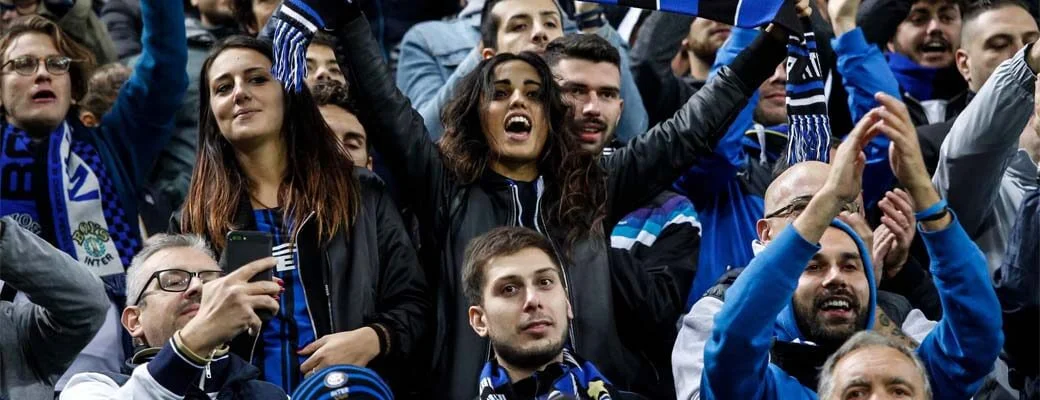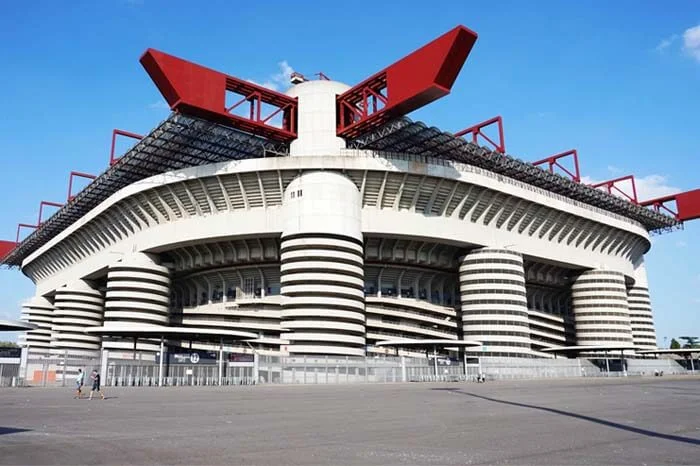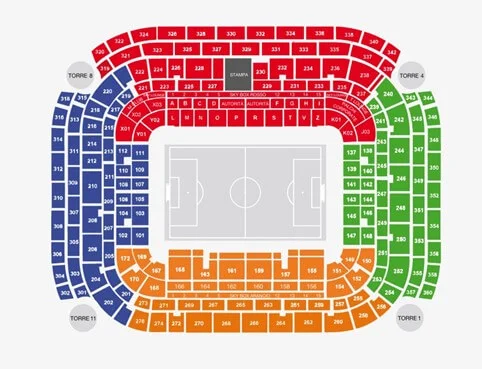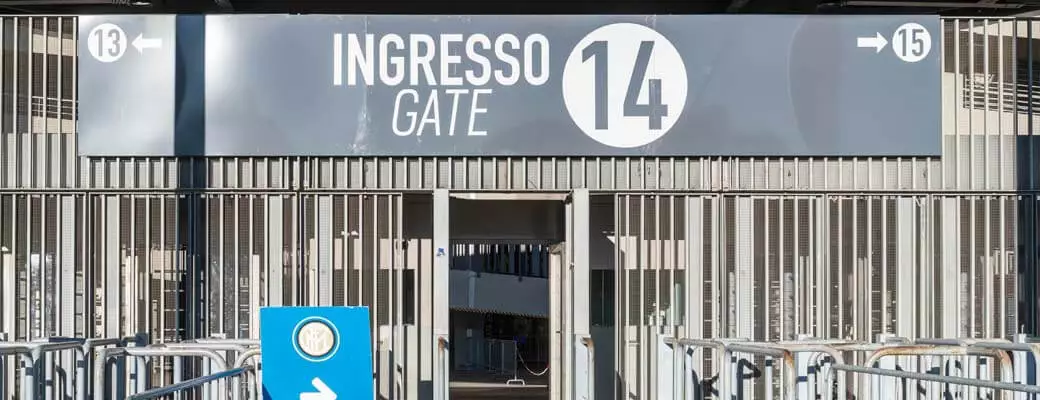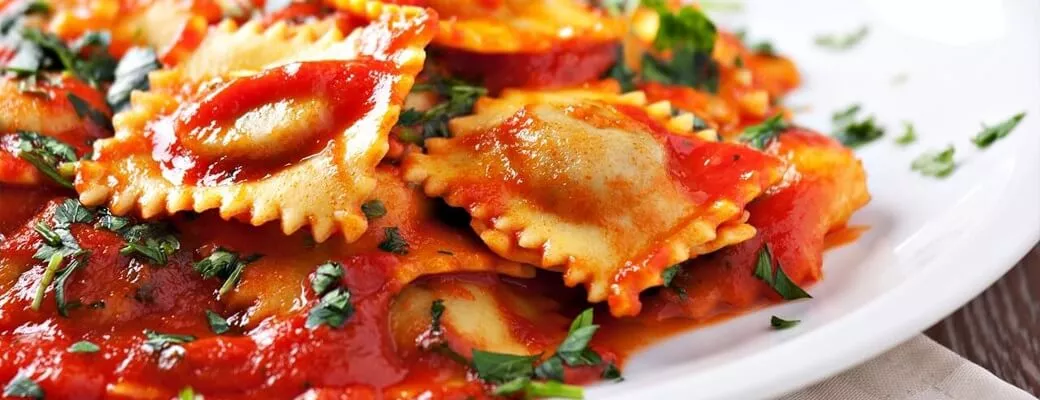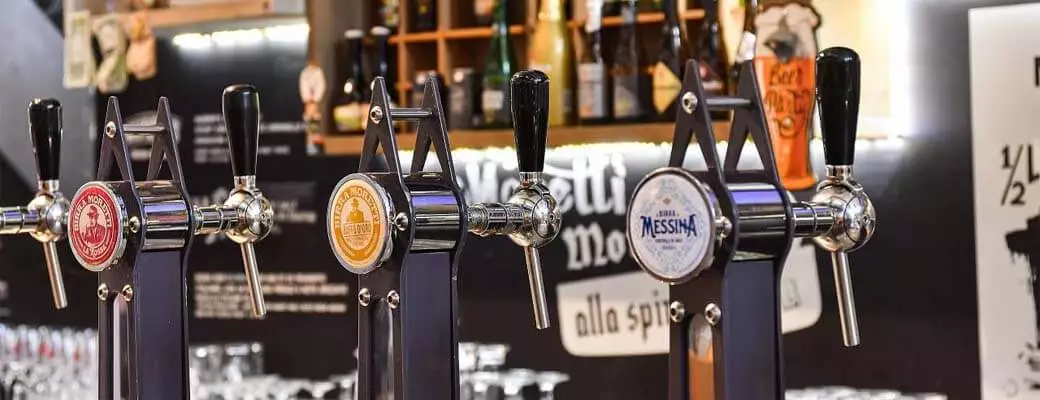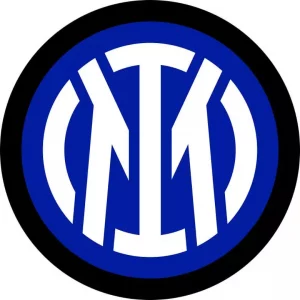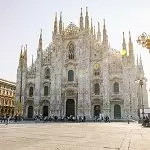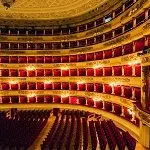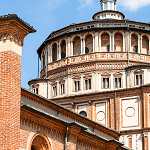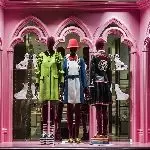Tip! Make sure you have a valid ticket. + Read more
- Paper or e-tickets
- A carefree experience
Inter Milan

Football trip
Inter Milan

Tip! Make sure you have a valid ticket. + Read more
- Paper or e-tickets
- A carefree experience
Tip! Make sure you have a valid ticket. + Read more


Tip! Make sure you have a valid ticket. + Read more
Book your complete football trip to Inter Milan with ease. Choose which match, hotel & seat all in one place. No booking fees.
Seize your chance and see an Inter Milan match at the hallowed San Siro stadium. In a few years, the wrecking ball will put an end to this stadium with its glorious history.
After a few lesser years, Inter Milan is also back at the top, as evidenced by the national championship in 2021 and reaching the Europa League final in 2020. With a package deal from Footballbreak.co.uk, you can be there yourself and enjoy a match of the Nerrazurri and their passionate supporters.
During your trip, there is also enough time to discover the vibrant city of Milan. Of course, everyone knows the world-famous cathedral, but the city offers many more top attractions that you should definitely visit!
We have put together the best tips to make sure you get the most out of your football trip to Inter Milan. From practical information about the San Siro stadium to suggestions for exploring Milan.
Officially, the stadium has been called Stadio Giuseppe Meazza since 1980, in memory of the footballer who played for both Inter and AC Milan between 1927 and 1947. Since Meazza achieved his greatest successes with Inter, AC Milan supporters will never use this name. But also worldwide football fans know this football arena mainly as San Siro, after the district where the stadium is located.
The construction of San Siro started in 1925. It was the first Italian stadium built solely for football matches, and therefore did not have a running track around the pitch. Inter Milan only moved to San Siro in 1947. From then on, both archrivals used this football temple with its characteristic corner towers every other week.
In 1989, a major renovation took place in preparation for the 1990 World Cup, when a third ring was built. With currently 75,923 seats, San Siro is the largest stadium in Italy. It has hosted two World Cups (1934 and 1990), one European Championship (1980) and four European Cup finals.
If you still want to see a match in this football sanctuary, you will have to hurry a little. It looks like San Siro will be demolished after the Winter Olympics in 2026. A new 60,000-seater stadium is to be built a little further down the road. For the first time, supporters of AC and Inter are joining forces to prevent the demolition. However, the chances that the demolition can be stopped are minimal.
The stadium is located in the west of Milan, about six kilometres from the city centre, and can be easily reached by public transport.
By metro
The Milan Metro is not only the most ideal means of transport to explore the city, but also to get to the San Siro Stadium. The metro has four different lines, all with their own colour and number. Since 2015, the stadium has had its own metro station, San Siro Stadio. It is the terminus of (the purple) line 5 and is located exactly opposite the stadium.
Many fans still use the old route: they take Line 1 and get off at Lotto station. It is then a ten minute walk past many souvenir and food stalls.
San Siro Address
Address San Siro Stadium
Piazzale Angelo Moratti
20151 Milano, Italy
By tram
If you prefer not to travel underground, you can also take the tram. The orange line 16 (Monte Velino – San Siro Stadio) will take you from the centre (Duomo stop) to the Piazzale Axum stop, opposite the stadium, in half an hour.
By bus
There are several bus lines that take you close to the stadium. You can choose from the lines:
By taxi
It is also possible to travel from the city centre to the stadium by taxi. Expect to travel 12 kilometres (around 30 minutes) and to pay around €22.
The colour of the seats distinguishes the four sectors into which the stadium is divided.
The sides of the stadium are:
Curva Nord (green): behind the north goal of the stadium.
Here you will find: sectors 137 to 148 (1st ring), 239 to 254 (2nd ring) and 343 to 360 (3rd ring). The Curva Nord is home to Inter’s most fanatical supporters. The Ultra’s with their chants, banners and flags ensure ninety minutes of a great atmosphere. Bear in mind that you will also be expected to stand and sing here throughout the match.
Curva Sud (blue): behind the south goal.
Here you will find the sections 101-112, 201-220 and 301-1318.
The sections 301 to 318 are for the supporters of the away team. It is also the section where the hardcore supporters of AC Milan sit during their home matches.
Rosso stand (red): Sections A-Z, X01-X03, Y01-Y02, J01-J03, K01-K02, 221 t/m 238 and 319 t/m 342. The red side is the main stand. You will find the most expensive seats here, such as the Premium Skybox seats and Executive lounges. It is also the side with the changing rooms, players’ tunnel and dugouts.
Arancio stand (orange): along the east side of the pitch, with sectors 149 to 172 and 255 to 276. This is the only side of the stadium with only two rings.
Of course, your football trip is not complete without a stadium tour and a visit to the museum. Here you will not only find the history of Inter, but also that of arch-rival AC Milan. Do not be surprised if you are face to face with lifelike dolls of Gullit, Rijkaard and Van Basten! You will also find the many cups won by both teams.
Afterwards, you can visit the changing rooms of both Inter and AC Milan, and step out onto the pitch through the players’ tunnel. A visit to the Club Store is also included.
The tours take place daily from 9:30 until 17:30 (in summer until 18:00). On match days there are fewer tours. It is really a must to book online in advance (via www.sansirostadium.com/museum-tour/tour), otherwise there is a good chance that there are no more tickets available.
Adults pay €20, children €13 and if you are under six you can enter for free. There are also special family tickets (2 adults and 2 children) for €55.
It is advisable to satisfy your hunger and thirst in advance, because once you have passed the entrance gates of San Siro, the supply is extremely poor. Fortunately, you stumble over the food stalls around the stadium.
You can find anything here: paninis with roasted pork, hamburgers, hot dogs and, of course, pizza. If you prefer sweets, choose Il Padrino, a stall that serves a wide range of Sicilian desserts, sweets and confectionary. The prices are quite decent, too.
Just a five-minute walk from San Siro, you’ll find this top spot serving authentic Italian meals. Antipasti, pizza, tagliatelle salmon or pasta bolognese: everything tastes great here. Don’t forget the famous tiramisu. The modest prices and the service are enthusiastically praised by visitors. In short: the ideal place to start the day!
You can find La Barchetta at the Via Frederico Tesio 15. The restaurant is open from 12:00 to 14:30 and from 19:00 to 23:45.
At Via Procaccini 61, just a few metro stops from San Siro, you will find this very tastefully decorated Sportsbar. From bottom to top, the walls are papered with scarves from countless football clubs. The other striking features are the large TVs and the long row of taps, with beer from Ireland, Germany, Belgium and, of course, Italy. A great place to enjoy a beer while watching a match on screen with dozens of other fans.
Close to the Plaza del Duomo, in Via Valpetrosa 5, you will find a very nice sports bar. Because it is hidden in a side street, this bar is not overrun by tourists yet. All walls are filled with football memorabilia. They serve a wide range of beers, including the Irish Guinness. The burgers are also very tasty.
Inter Milan was founded in 1908, when disgruntled members left AC Milan, founded in 1899. The reason for this split: AC Milan refused to admit footballers of foreign origin, even if they had lived in the city for years. The pure Italian character of the club had to be preserved. Opponents of this policy resigned and founded a new football club with the significant name of Internazionale.
Although the club won several national titles, it did not immediately succeed in winning a European title. Until Helenio Herrera took over as coach in 1960. The Argentine introduced catenaccio: extremely defensive form of football, with a couple of purposeful attackers to strike on the counter. The successes were not long in coming: In 1964, Grande Inter won both the European Cup 1 and the World Cup. A year later, the club repeated this feat.
However, a long drought followed. In the nineties, the club won the UEFA Cup three times, but had to grit its teeth watching rival AC Milan string together international successes. Only in 2010, with a brilliant Wesley Sneijder, did they win the national title, the Champions League and the World Cup.
The match of the year is of course the Derby della Madonnina with AC Milan. Inter used to represent mainly the wealthy bourgeoisie, while AC Milan enjoyed the sympathy of the working class. Because the Inter fans could afford to come to the football by motorbike, the club got the nickname Motoretta.
On 8 March 2021, the day on which Inter celebrated its 113th anniversary, the club presented its new logo. It was also the 14th time that the logo was changed.
According to the club, the new logo is ‘innovative, elegant and fits better with the current entertainment era’. The golden colour disappears, as do the letters ‘FC’.
Inter is more than football, it is also a fashion and lifestyle brand, according to the policy makers. What remains is a concentric circle with the letters I and M in it.
With this remarkable step, the club follows the example of Juventus, which launched a minimalist logo in 2017. Clothing with the new logo is already on sale in the club store, from the 2022-2023 season it will also adorn the shirts of the Nerazzurri.
Contrary to its logo, Inter has always remained true to its black and blue striped shirt. According to tradition, these colours symbolise the night sky: blue for the sky and black for the night. This was chosen because the club was founded late at night at 23:30. Blue was also selected because it was said to be the opposite colour to AC Milan’s red. The colours also earned Inter its nickname Nerazurri, which means ‘black and blue’. A snake is often depicted (or referred to) on the jersey. The snake has great symbolic meaning for the city of Milan.
Milan is best known as a fashion centre, but there is so much more to Italy’s second city that a few days are hardly enough. The impressive cathedral is of course an absolute must, but we have also listed a few other must-see places for you.
Milan’s Duomo lies in the heart of the city and is one of the largest Roman Catholic cathedrals in the world. No less than 600 years were spent working on the 14th-century cathedral. It was not until 1950 that construction was completed, after which work began on restoring older parts of the cathedral. The façade, with its 135 towers and 3,400 statues, is truly dazzling. But also the beautiful interior is not to be missed. The highlight is a visit to the roof, where you can see the statues up close. You also have a great view over the city. On a clear day, you can even see the Italian Alps.
Until a few years ago, you could enter for free, but those days are over. Tickets for the cathedral cost €5, including the museum €10. If you want to go to the roof as well, you have to pay €15 for the stairs and €20 for a trip with the lift. Please note that your bag will be checked and that you cannot enter in shorts or t-shirts. Another tip: go early in the morning when it is less crowded.
You can shop in style in this shopping centre, which consists of four galleries with a glass ceiling that come together in a transparent dome. The marble floor is inlaid with beautiful mosaics. The shops themselves are also a feast for the eyes. You will find branches of the most luxurious brands interspersed with stylish cafés. If you have already spent most of your travel money in the Inter Clubstore, there is also a McDonalds.
This church and its cloister are on the Unesco World Heritage List. This monument owes its status to the presence of ‘The Last Supper’, the world-famous wall painting by Leonardo Da Vinci. Remarkably, most of the church was destroyed in the Second World War during bombing raids, but Da Vinci’s painting remained unharmed. A word of warning: to see this work of art, you must make a reservation online in advance. Every 15 minutes, 26 people are allowed to visit the painting. Admission is €15. Young people under eighteen can enter for free, but they too must book in advance.
Navigli is known as the most authentic and romantic district of Milan. The streets are intersected by canals, and connected by small bridges. It is a bit like the canals of Amsterdam. The canals were built from the 12th century onwards, so that boats could deliver coal and salt to the city. The marble for the Dom was also brought in this way. Especially in the evening, there is a great atmosphere, when thousands of people enjoy a snack and drink in one of the many restaurants. There are studios and specialised vinyl and book shops, as well as the best ice cream in town.
